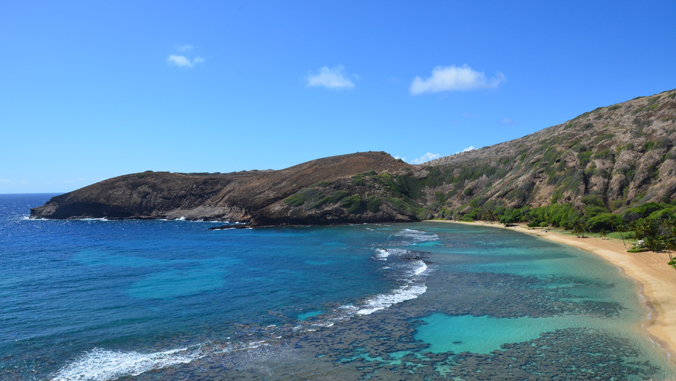
A five-year study into the impacts of sea-level rise on the Hanauma Bay Nature Preserve (HBNP) predicts 88% of the preserve’s usable beach will be underwater by 2030.
Conducted by researchers at the University of Hawaiʻi at Mānoa Hawaiʻi Institute of Marine Biology (HIMB), the study evaluated the biological, physical, and social carrying capacities of this pristine natural destination; taking into account the impact of visitors to assist in planning for sustainable tourism. In Hawaiʻi, warm ocean temperatures and high water visibility draw more than 85% of tourists to ocean recreation activities, with a similar percentage of entries into Hanauma Bay (about 85%) coming from non-local visitors.
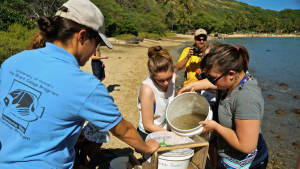
The study, which spanned the nine-month pandemic closure of HBNP in 2020, includes predictions of how the rising sea level may impact this pristine natural destination. Models show the combination of the lowest predicted sea-level rise (0.5 feet) and highest tide will result in 88% of HBNP’s usable beach being submerged by 2030. “Usable beach” is defined as the sandy area.
“The predictions of the extent that sea level will impact the usable area at Hanauma Bay was eye-opening,” said Kuʻulei Rodgers, researcher at HIMB. “It will assist management in preparation and to develop recommendations, other alternatives and solutions.”
The sea-level rise models used by Rodgers and her team were developed by the School of Ocean and Earth Science and Technology’s Sea Level Rise Laboratory and Pacific Islands Ocean Observing System.
Other findings in the study include fluctuations of the abundance and diversity of fish, water clarity increases during the closure, and the increased use of HBNP by local residents.
Fish flight initiation
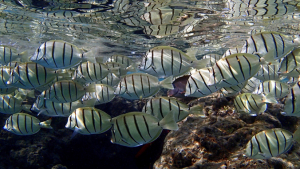
Researchers conducted non-invasive stereo video monitoring, a two-camera technique used to create a 3D image without harming the fish, to determine the fish flight initiation distance and the minimum approach distance for different species. Basically, how close humans can get to certain fish before they swim away.
The majority of fish were more approachable and fled later during the closure. A few species such as pualu, the ringtail surgeonfish, did not appear to perceive visitors as a threat. Possibly due to their larger size. This was contradictory to wrasses and butterflyfish, which were among other species found to be less approachable upon reopening.
Also observed during the pandemic closure were increases in fish abundance and biomass. When researchers examined fish community compositional shifts they noticed a corresponding decrease in the amount and diversity of fish following the reopening of HBNP in December 2020. Most notably the “keyhole,” the most popular snorkeling location within the shallow reef flat, saw substantial increases in fish communities during the closure.
Visitor demographics
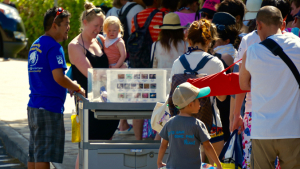
Surveys were conducted following the reopening of HBNP in December 2020. At this time, there were quarantine restrictions upon returning to Japan, which resulted in a drop of visitors from Japan from 25% in 2005 to less than 1% in 2022.
Another shift in demographics is the increase in Hawaiʻi residents from 3% in 2001 to 13% in 2022. Management has been instrumental in this change by allowing early entry for Hawaiʻi residents without reservations and the continued fee waiver.
The preservation of Hawaiʻi’s nearshore ecosystem is imperative to the economic continuation of the tourism industry. In the 1980’s, HBNP visitor use reached a peak of 4 million visitors annually. In 2023, visitor use is projected to be down to approximately 500,000 annually. Contributing factors include: closing HBNP two days per week, a reservation system, increased fees, and effective management strategies.
Water clarity
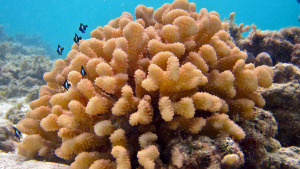
During the pandemic closure, the water clarity was 56% clearer as compared to prior to the closure. Following the reopening of HBNP at 25% visitor capacity, the water clarity decreased by 30%.
Other factors such as wave height contributed to decreases in water clarity along with visitor counts. However, visitors were the most influential factor.
Research that contributed to this work was published in Nature Communications, Biological Conservation and Tourism Recreation Research.
Graduate assistants who also contributed to this research include: Andrew Graham, Yuko Stender and Shannon Murphy, and research assistant Kaylee Skidmore-Rossing.

